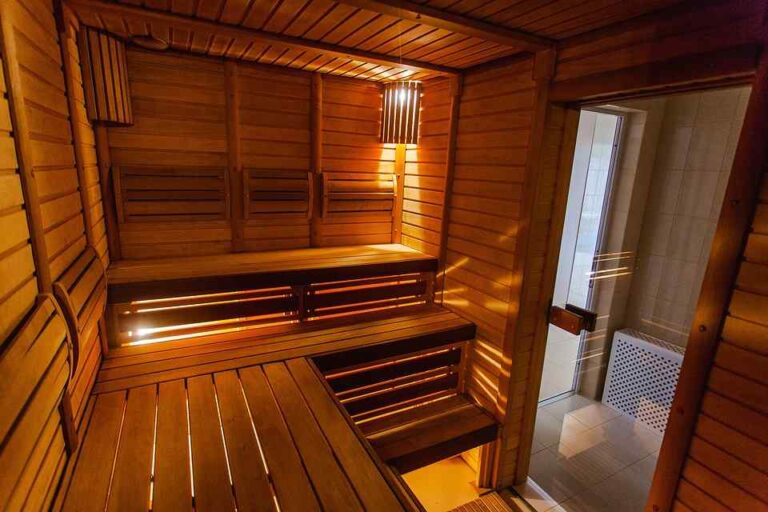Saunas are very popular due to the health benefits they offer. These include purifying the skin and detoxifying the body as a result of the heat, which makes you sweat. Infrared light can also penetrate the skin and heal the dermis and epidermis while improving skin tone.
However, as technology evolves, there is a new range of saunas that use infrared technology to raise the room temperature, as opposed to traditional heat sources. This makes them safer to use, faster, and more energy-efficient.
Difference Between Traditional and Infrared Saunas
The first thing to understand when choosing a sauna is the difference between a traditional sauna and an infrared one. One of the main differences between a traditional sauna and an infrared one is the heat of the unit.
Traditional saunas use temperatures as high as 185 to 195 degrees F, which can overwhelm those who are more sensitive to heat. However, because the heat from infrared saunas penetrates the body, they can cause a more vigorous sweat at a lower temperature of 120 to 150 degrees F.
A traditional dry sauna uses a stove to heat the air, while infrared saunas use infrared heaters to emit a specific wavelength of infrared light. The infrared sauna produces the same effects as a traditional sauna with less overall heat required.
Humidity is another difference. Unlike traditional saunas, infrared saunas do not use steam and rely entirely on the heat of infrared heaters for overall effects.
Another difference between a traditional sauna and an infrared one is the amount of energy required to operate each unit. Traditional saunas require more total power to run, with a typical sauna consuming 6 kW of power compared to the typical 1.6 kW required for an infrared sauna. This means that a traditional sauna is almost three times more expensive to operate than an infrared one.
Near-Infrared vs Far Infrared
Infrared saunas work in the same way as the sun. The sun’s ultraviolet rays penetrate your skin and heat it in the same way that the infrared rays from the sauna penetrate and heal your skin. When you look at the types of saunas to choose from, you will notice that there are near-infrared saunas and far-infrared saunas, but what does this all mean?
The difference between the two has to do with the spectrum of light. When you feel the heat of the sun, you feel a lot of near-infrared light. Half of the spectrum of light emitted by the sun is in the near-infrared spectrum.
This light penetrates up to 5mm below the skin and we use this energy to produce vitamin D. This means that near-infrared saunas are great for our skin and also for our overall health and well-being. Light raises our core temperature, improves our circulation, and can even relieve pain.
Far infrared is similar to near-infrared, except for the wavelength of both lights. The water in our body mainly absorbs the far infrared and, for that reason, only penetrates 0.1 mm below the skin. Although absorbed by water in the body, far infrared light can cause alterations in the protein structures of the body.
These can help jumpstart your metabolism, strengthen your immune system, detoxify you, and help you lose weight. They both have benefits, and whichever one you use, will benefit you.
Carbon fiber infrared saunas vs Ceramic infrared saunas
To choose between an infrared sauna with a carbon fiber heater and one with a ceramic heater, you need to understand their differences. Infrared saunas with ceramic heaters heat up quickly, allowing you to enjoy the sauna at your desired temperature, typically in 8-10 minutes.
Carbon fiber heaters are thin and have a large surface area that heats up at a lower temperature. Heat is dispersed more evenly over larger surface areas, making them more suitable for full-body therapy. Carbon fiber heaters are more energy-efficient, but ceramic ones are cheaper.
How to Choose the Best Infrared Sauna
Capacity And Dimensions
When buying an infrared sauna, capacity plays a big factor, as most infrared saunas are designed to fit only two or three people at a time.
To accommodate more people, you need a larger sauna. You should also consider the dimensions of the sauna. Smaller infrared saunas will take up a smaller space than larger ones, so you need to make sure you have enough space for whatever you choose.
Type Of Heaters
Carbon and ceramic are the two main enemies used in infrared saunas, but you can also find mica. As we already mentioned, charcoal heaters are more efficient, but you will have to pay more for them.
Ceramic heaters perform well and you won’t have to pay as much. Mica is the cheapest, but its performance does not compare to the other two. We recommend carbon if you can afford it, but ceramic will work well if you want something more affordable.
Heating Surface
Small surfaces heat up faster than larger surfaces. If you have an infrared sauna made up of small plates, the sauna will heat up very quickly. With large surfaces, the heating time is longer, but they give a more uniform heat in the sauna. They are also easier to manage, and fewer things can go wrong. The larger the surface area the better, but for cost and time, we recommend something in between to get the best balance between effectiveness and cost.
Construction Materials
Better materials will cost you more money. They will also do a better job of containing the heat in your sauna. You don’t need to spend a lot of money on the best materials, but you shouldn’t skimp on your building supplies, either.
Cedar is traditionally used in infrared saunas (and in any building affected by humidity). Cedar is always the right choice for your sauna.
Heater Covers
You must have a cover for your heater so that it does not become a hazard. If the heat source comes in contact with your skin, you could be seriously burned.
The best infrared sauna will come with a cover included, but if it doesn’t, you should consider investing in a good one. Good coverage (if not included) can cost you some money. But it is better to spend a little more to ensure your safety (and that of your guests).
Safety
When it comes to buying the best-infrared sauna, your safety should be your top priority. One way to ensure the safety of your infrared sauna is to look for reputable certified companies. Companies that are ISO or CE-certified can be trusted. There are other certifications, so if you see a company advertising a certification, you should take a look.
The other thing you can do is check the reviews. If the business has been in business for a long time, you should be able to see the revision history. If something has gone wrong with saunas in the past, you will find a review that will inform you of the dangers.
Warranty
With any large purchase, and especially with an appliance, you should expect to have a warranty on it. Your sauna will wear out over time. There is also the possibility of an infrared sauna breaking due to misuse, accidents, or improper assembly. There may be problems with the manufacturer or unforeseen breakages.
Most infrared saunas come with a warranty, and you should be sure to check the warranty before purchasing the sauna. The longer the warranty the better, but you should read the fine print before committing.
You need to check to see what is covered. Some warranties have limited coverage and some are all-inclusive. An extended warranty that doesn’t cover much can be useless for you. Find the best balance between coverage and price.
See More: Ways to Protect Your Skin During Cold Weather & Temperature



